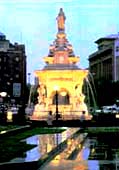Bombay Meri Jaan

Celebrating a city like none other
Arun Katiyar
Photographs by Namas Bhojani
Travellers usually have a story to tell. This one by itinerant
journalist Sunil Sethi who writes for The Economist is my favourite:
"I ran into a talkative Chinese while walking down the bund
in Shanghai. He must have figured that I was either Indian or
Pakistani because in the torrent of Shanghainese I could pick
only two words: Bombay and Karachi. Perhaps he wanted to know
where I was from. Delhi, I said, then repeated it several times.
The man repeated the word after me, as an alien sound. Clearly,
he had never heard of the place. But when I said Bombay, he beamed
and shook my hand. As one wayfarer to another, we only understood
the sound of a big city."

Bombay is vast. Obsessed with himself, the average Bombaywallah
doesn't notice it. If he did, he'd see about 600 square kilometres
of squalor and chaos. The welter of slums would fill him with
loathing. He'd be appalled by the decay which appears to lurk
in the very soul of the city. But the Bombaywallah has trained himself
to ignore these traits. He has learnt to look higher and harder.
Around him, in his city, he sees only the delicate colours of
spring. His streets still carry the names for flowers and fruits
and trees Labarnum Road, Jambul Wadi, Gulmohur Road. Sometimes,
if you pay attention, you can also hear the birds sing. But amidst
all this, the Bombaywallah hears only the sound of opportunity.
His restless ambitions have helped raise a city of gleaming towers
and atomic reactors, glitzy shopping arcades and famed institutions
of learning.
For him, Bombay is a sprawling dream factory that
doesn't take a break between shifts. It is the sort of place that
gets instant recognition on a bund in Shanghai. Or gets mentioned
in the same breath as the great cities of the world.

Much of this is a matter of perception. Anita Pratap, a journalist
working out of Delhi for television's CNN, once spent an evening
with us. Sitting at the neon-lit Toto's Garage in Bandra over
a couple of drinks, the conversation drifted to the ethos of the
city. On a week day, late into the night the modest pub was humming
with life and rocking to the sound of the latest MTV hits. "Bombay,"
she said eyeing the spiffily dressed men and women, "is
like a foreign country."

Is Bombay divorced from the rest of the country? Rajiv Gandhi,
the late prime minister of India didn't think so. Speaking at
the Congress Centenary Session in 1985, held in Bombay, he remarked,
"Life giving currents from every part of the country flow
into Bombay. It is India in a microcosm." Bombaywallahs need
to down a very neat vodka and take a sober look at the confusion
they have created.
It could be that Bombay has a dreamlike quality about everything.
And much depends on which part of the dream you step into. Should
you arrive on the nightmare stretches -- garbage on the streets,
the rampant spread of AIDS, giddy real estate prices - you might
be tempted to look for escape to more peaceful climes. Don't succumb.
Observe how people from peaceful Pattadakal and bucolic Bidar
are coming to Bombay.

They come, of course, searching for the dream of a better life.
Often they are rewarded. Supreme Court advocate Ram Jethmalani
arrived as a refugee from Karachi in 1947 with a tenner in his
pocket (okay, he also sneaked in a toothbrush) and built a successful
career defending smugglers and murderers. Actor Amitabh Bachchan
slept on a bench along Marine Drive and within a decade rose to
become a superstar whose charisma refuses to wane.
Naturally, the myth of Bombay has grown. Now everyone suspects
that dreams are in the realm of the possible, more so in Bombay.
So they come looking for the impossible. They come chasing fiction.
They pursue a city they have glimpsed in the movies. Or in the
powerful images created by photographers for glossy magazines
and travel brochures that conjure a romantic metropolis. Bombay,
ever obliging, meets them halfway, with a bizarre panorama of
saints and shamans, slums and skyscrapers, hussies on street corners
and lunatics on the run. The montage of hope and hooey spans a
fascinating array of life, from the dreadfully creative to the
resolutely suicidal.
Excerpted from Bombay: A Contemporary Account of Mumbai Namas Bhojani, Arun Katiyar,
HarperCollins, 1996, Rs 2,500/ US $ 70, with the publisher's permission.
Readers who wish to buy the book may contact Ashwini Bhatia, Harper Collins India, 7/16,
Ansari Road, Daryaganj, New Delhi 110002, tel # 011-3278586, 011-3272161, fax # 011-3277294.
|

